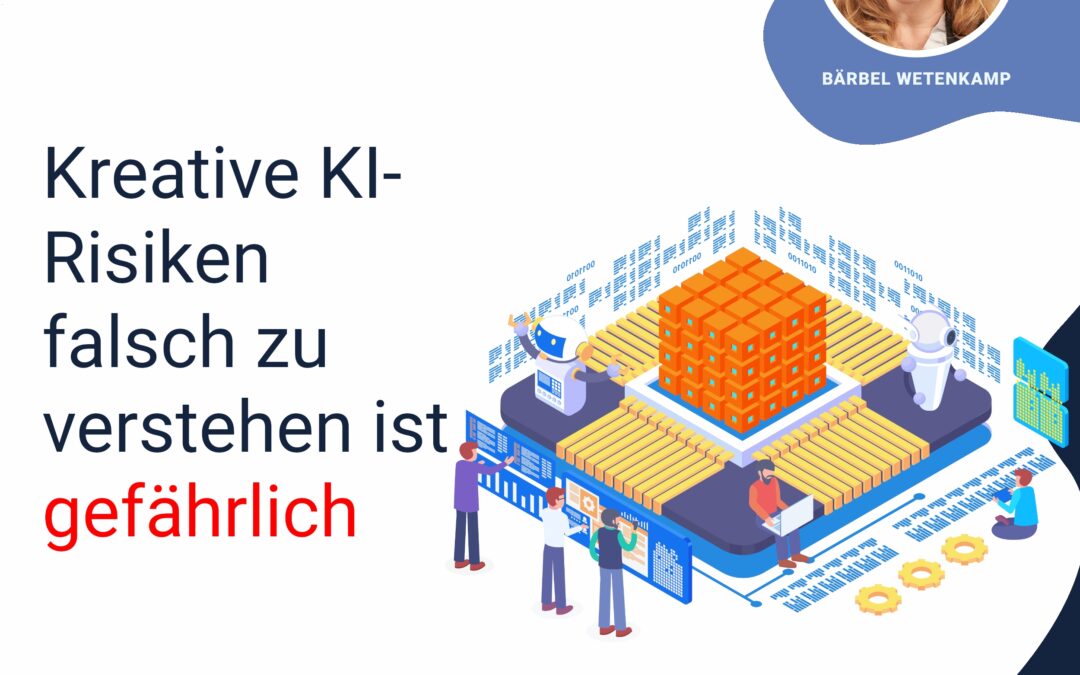Navigating the Complexities of Generative Artificial Intelligence in the Corporate World
The realm of Generative Artificial Intelligence (AI) has brought forth unprecedented opportunities for businesses, but as the quote “Kreative KI-Risiken falsch zu verstehen ist gefährlich” – “Misunderstanding the risks of creative AI is dangerous” – suggests, there is a critical need for comprehensive understanding and management of these risks.
The Promise and Perils of Generative AI
Generative AI has indeed emerged as a transformative force in the business landscape, driving innovation and efficiency to new heights. Its capacity to automate complex operations, offer intelligent solutions, and facilitate creative problem-solving has made it an invaluable asset for businesses seeking to maintain a competitive edge. For instance, in marketing, Generative AI can tailor content to specific customer segments, creating more impactful and personalized campaigns. In product development, it enables rapid prototyping and testing, reducing time-to-market for new products.
Moreover, the technology’s prowess in processing and analyzing large datasets has brought a paradigm shift in decision-making. Businesses can now leverage predictive analytics and deep insights to make more informed, data-driven decisions. This capability extends from understanding consumer behavior to optimizing supply chain operations, thereby enhancing overall business performance.
However, alongside these remarkable benefits, Generative AI introduces significant risks that require careful consideration and management. Data security is a primary concern, as the reliance on vast amounts of data raises the possibility of breaches and unauthorized access. The ethical use of AI is another critical area, especially regarding privacy concerns and the potential for biases in decision-making processes. These issues are not just technical but also ethical and legal, requiring businesses to establish comprehensive policies and practices to ensure responsible AI use.
The potential misuse of Generative AI technologies, such as the creation of deepfakes, also poses a threat to the integrity and trustworthiness of information. Such misuse can have serious implications for individuals and organizations, from reputational damage to legal complications. As a result, businesses must not only invest in robust cybersecurity measures but also actively engage in monitoring and regulating the use of AI within their operations.
In summary, while Generative AI is a powerful driver of business innovation and success, it also necessitates a proactive approach to managing the associated risks. This includes implementing strong data security protocols, adhering to ethical AI practices, and staying vigilant against potential misuses of the technology. By doing so, businesses can fully capitalize on the benefits of Generative AI while minimizing its risks, ensuring sustainable growth and success in an increasingly digital world.
The Challenge of Risk Management in AI
Effective risk management in the context of Generative AI involves not only understanding the technological intricacies but also foreseeing the broader implications of its application. Businesses must be vigilant in identifying potential vulnerabilities and proactive in implementing safeguards to protect sensitive data and maintain ethical standards.
The Role of Leadership and Change Management
Steering Through AI Integration: Leadership plays a pivotal role in the successful integration of AI technologies. Executives and managers must not only be technologically adept but also skilled in leading their organizations through the complexities of digital transformation.
Executive Coaching for AI Challenges
Executive coaching services are essential in preparing leaders for the challenges of AI integration. Coaching can provide the tools and insights needed for leaders to effectively manage change, communicate the implications of AI to their teams, and foster an environment of continuous learning and adaptation.
Effective Communication: A Key to AI Success
Clear and effective communication is vital in demystifying AI technologies for employees and stakeholders. It involves transparently discussing the capabilities, limitations, and ethical considerations of AI, thereby building a culture of trust and informed collaboration.
Developing AI Literacy
Part of managing AI risks effectively is ensuring that all levels of the organization have a basic understanding of AI technologies. This includes regular training sessions and workshops to keep everyone updated on the latest developments and best practices in AI usage.
Conclusion: Embracing AI with Awareness and Responsibility
In conclusion, while Generative AI offers significant benefits for businesses, understanding and managing its risks is not just important – it’s imperative for success. As the quote aptly warns, misunderstanding these risks can lead to detrimental consequences. Therefore, businesses must approach AI integration with a well-informed strategy, robust risk management practices, and strong leadership to harness the full potential of this transformative technology.
#GenerativeAI, #AIrisks, #BusinessInnovation, #DataSecurity, #AIinBusiness









